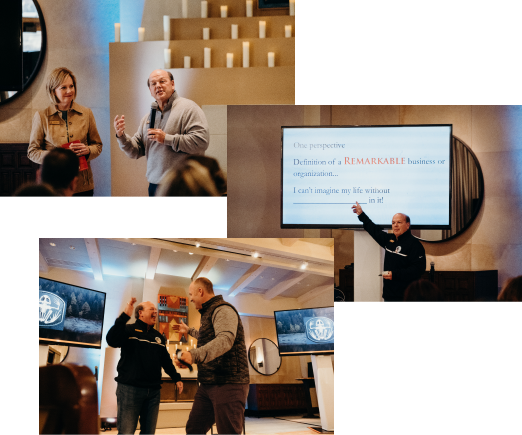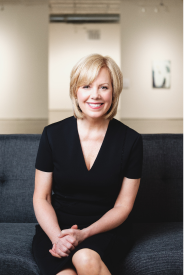David: Ginger, you often talk about the 5 Lies of Organizational Culture, and I can’t wait for our tribe here at Spark a Revolution to hear all about them. Let’s start with the first one, though: how can leaders counteract the idea that culture is someone else’s job?
Ginger: For people who think that culture is someone else’s job, I want to retort that the truth is culture isn’t someone else’s job and, especially for leaders, culture building is a requirement. I got to witness that firsthand during my 25 years at Southwest Airlines through our founder Herb Kelleher who really set the tone along with our President Emeritus, Colleen Barrett. They really lived the culture and set the tone. The challenge for many organizations is to keep that going. And Southwest has definitely done that through CEO Gary Kelly. He’s been CEO since 2004 and the way he continues to set that tone for putting culture at the top of the list is one of the strengths of the organization. What I tell leaders is, whether you have a team of five people or if you have a team of 500 people, building the culture and setting the tone for the organization is part of your job description. Organizations that are the strongest look at culture as being everyone’s job. Ultimately, the leader sets the tone and culture building is a requirement for all leaders in the organization.
David: You know Ginger as you were saying that it kind of occurred to me that I had a similar experience at Chick-fil-A with the Founder, Truett Cathy, who set the tone for the culture. I wonder if the Founder always understands that culture is the ultimate competitive advantage but that when you get to a second or third generation leader, they can be tempted to take that strong culture for granted and don’t do the things that you need to do to cultivate and fertilize that culture. It may be why we see so many businesses fail in the third generation because they lose sight of what the original founders innately understood.
Ginger: I think you’re onto something there, David, because you have to continually put focus on culture building. If leaders don’t, they’re still going to have a culture, it just might not be the one that will be the most productive for the organization.
David: What lie do people often fall into when it comes to their organization’s Values?
Ginger: That’s a great one because too many companies spend time articulating their values, even post them on a wall, and then they just go on about the business of work and really don’t revisit those values often. Culture isn’t a faucet that you can turn on and off. Basic-level organizations will post their values but best-in-class organizations know that they have to weave them through every touchpoint in the employee experience. So, they start all the way back before they even make a hire – they’re starting in recruiting. You’re seeing that on their Glassdoor and on their career website that they’re already starting to talk about their values and the kind of people they’re looking to bring into the organization. They weave it through hiring, onboarding, training, job delivery, recognition, and all the way through performance management. Best in class organizations are looking at weaving culture through every aspect of any employee experience.
David: Ginger I’m curious, as you think about the hiring process, were there any little unique things about hiring at Southwest as it relates to values?
Ginger: In terms of hiring for values, Southwest also believed the popular Human Resources saying to “hire tough so you can manage easy,” so we spent a lot of time on hiring. In a typical year, Southwest receives about 300,000 applications and of that, only hires 2% of the people. In those interviews people will be asked very specific questions, such as, “tell us about a difficult customer service moment for you and how did you handle that?” They’re not aspirational questions about ‘what would you do,’ but they’re very direct questions that go back to values about ‘what did you do’ in your previous experience. There’s a famous story at Southwest about a Top Gun pilot who had a great resume. This Top Gun pilot applied and came in for an interview but he was rude to the receptionist and he was rude to the recruiter, so he did not get hired. That is a case of someone coming in with the top skills for a particular job but if they don’t fit the values about not taking themselves too seriously, or treating others with respect, they’re not going to get hired.
David: Yes, I think sometimes values are reflected as much in what we say no to as what we say yes to. Lie #3 is one of my favorites and it’s that Culture is Fluffy – what do you mean by that?
Ginger: I think a lot of people avoid culture because they think it means balloons or streamers or that they have to be the loudest person in the room. There is a trend these days that if you have a ping pong table that means you’re cool and you have culture. There’s so much more to creating a culture. If you have a strong culture, you really can drive bottom line results. I love to give examples of what I call “return on culture” where organizations that focus on culture make a difference. My favorite, and you’re going to love it, is in the casual restaurant sector: Chick-fil-A which ranks number one in revenue for restaurants. Then you’ve got Trader Joe’s that leads in the grocery sector in both financial performance and consumer preference. And finally, of course, is my favorite, Southwest Airlines, which has been profitable for 46 consecutive years and that’s hard to argue with. These are organizations that really try to dissect how they can continue to up their game and their culture. Every day, Southwest sends out 10,000 surveys to judge the customer experience. They ask questions all the way from check-in to picking up your luggage with the goal of improving the customer experience. One of the things that is consistent, even if your flight starts out in a negative way, is that the flight attendants have the ability to turn your impression of that flight around just by the way they’re delivering on hospitality and great customer service. It’s the importance of every employee understanding that they have the ability to change that customer’s experience by their personal interactions with that customer.
David: That’s not fluffy! Empowering employees is crucial to a strong culture and we’ve both seen that play out in our own experiences. How can leaders avoid the lie that empowering employees leads to losing control?
Ginger: We’ve all experienced a micromanager and that’s one of the things that shows up in so many employee surveys. I’m talking about a leader who has so much control and is not allowing employees to live out their personality which is the reason the organization hired that employee in the first place. One of the ways to look at empowering employees is practicing freedom in a framework. All organizations have a basic framework of how they want their employees to deliver on their product, but we also need to give them the freedom to live outside those circles. One example of a company who does that well is Soul Cycle, the indoor cycling class phenomena that started about 10 years ago and has grown to over 60 studios. Their female CEO established freedom in a framework by laying out a basic formula for a class design but allowing their instructors to curate it, produce their own workout and playlist, and really make it their own. The other example you might have seen at Southwest Airlines is the flight attendants who have the basic FAA required format for the in-flight message, but they turn it on its head. People really do listen because flight attendants are allowed to sing the message it or to tell funny jokes in the middle of it. This approach actually causes people to listen, enjoy, and probably chuckle along the way. All of us have encountered that employee who’s not delivering good customer service because they’re delivering a framework with no freedom, and it includes a lot of no’s and very few yeses. How can we create those opportunities for our employees where we give them a lot of freedom to deliver the right kind of customer service, based on their personality, that all of us are looking for in our company?
David: I often hear from organizations that they can’t afford culture – is that true, and what are some free culture-building activities that leaders can utilize?
Ginger: You’re right. Culture doesn’t have to cost a lot to be effective. One of the most important things that all of us as leaders can do is boost our visibility in the organization. Think about how important it was when you were that new leader and your boss came and checked on you and had a regular interest in what you were doing. All employees want to know that what they do matters and having that leader visibility is critical. The best leaders make sure they’re marking time on their calendar to spend with their employees. They vary their path going into the office every day so they can touch as many people as possible. At the opposite end of the spectrum: I once encountered a company whose executives had their own elevator so they wouldn’t have to interact with employees. Well, that’s the opposite of leadership visibility and it makes absolutely no sense because boosting leadership visibility is critical!
Another cost-effective strategy I encourage leaders to do is put storytelling front and center. Some of the best organizations lead by example in telling great stories about customer service and about employee interaction. So, look at ways to collect the stories that are already coming into your organization either through employees or through your customers. Look for ways to tell those stories back out into the organization. The CEO of Southwest Airlines, Gary Kelly, records a message every week to employees and at the end of the message he always includes a “shout out” about an example of an employee who has lived the values of the organization. That is something we can all do that doesn’t cost anything; start being a collector of stories, whether you’re the CEO or not. When we see great service in our organizations, when we see our employees living our values, how are we capturing those stories and telling them in our organizations?

David: Those are some awesome ideas. Well, I can’t tell you how thrilled I am to be a coach at your Unstoppable Cultures Fellowship this November. My experience at the first one in 2018 exceeded every expectation I had and I’m so glad we’ll have the opportunity to do it twice this year. What are you most looking forward to about the event?
Ginger: David, you’re such a draw for the Unstoppable Cultures Fellowship because of your experience, your track record with Chick-fil-A, and your ability as a master storyteller. What I’m looking forward to the most is the new group of people attending who represent all levels of their organizations; we have CEOs; we have heads of non-profits; we have Chief People Officers. It’s a diverse group of individuals that share the common goal of wanting to grow their business through helping to grow the culture in their organization. What we offer is a masterclass in culture from some of the best organizations- Chick-fil-A, Southwest Airlines, Navy SEALs, Zappos- telling their story and going deep on how they have built culture into their organization. I’m excited to see what the participants will pick up, not only from the coaches, but also from each other in terms of best practices. We’ll be helping every participant build out a Culture Blueprint so when they leave our event, they’ll have a plan that identifies how they will go back into their organization to grow the culture and impact the bottom line of their organization through culture and people development.
David: It sounds like we’re going to take some fluffy cultures and make them really dynamic! The Fellowship can’t get here fast enough as far as I’m concerned. The people who get to come, including myself, will be richly rewarded as a result.
About Ginger
Ginger Hardage recently retired as Senior Vice President of Culture and Communications at Southwest Airlines after 25 years, where she served as a member of the CEO’s executive leadership team. At Southwest, Ginger led a team of 150 people responsible for building and sustaining the organization’s legendary culture and communications enterprise. Most importantly, Ginger helped champion the values, purpose and “Best Place to Work” initiatives that made Southwest a perpetual standout on Fortune’s “Most Admired Companies in the World” list.
In 2017, Ginger launched Unstoppable Cultures, a brand designed to help organizations create and sustain cultures of enduring greatness.
Ginger has received numerous honors throughout her career, including induction into the Public Relations Hall of Fame and being named as one of Texas’ Most Powerful and Influential Women. She serves on the global board of Ronald McDonald House Charities and Trinity Park Conservancy.
